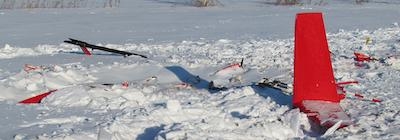Wed, Feb 20, 2019
Collision With Terrain Involving A Helicopter In Saint-Joachim-De-Courval, Quebec, Demonstrates The Risks Associated With Insufficient Recent Experience In Instrument Flight
In its investigation report (A18Q0016) released Monday, the Transportation Safety Board of Canada (TSB) underscored the risks posed by insufficient recent experience flying with reference to instruments, particularly in the case of night flights when unfavourable weather conditions are encountered and pilots lose visual reference to the ground.

On 01 February 2018, at about 1945 Eastern Standard Time, a privately operated Robinson R44 Raven I helicopter departed Saint-Georges de Beauce, Quebec, with the pilot and 2 passengers on board, on a night visual flight rules (VFR) flight to Saint-Alexis-de-Montcalm, Quebec. At 2032, the Canadian Mission Control Centre received a distress signal from the helicopter's emergency locator transmitter. At about 2135, the helicopter was found in a field in Saint-Joachim-de-Courval, near Drummondville. The helicopter was destroyed by the impact forces and a post-impact fire. All of the occupants were fatally injured.
The investigation determined that it is highly likely that the pilot encountered unfavourable weather conditions which led to a loss of visual references to the ground, and that he lost control of the helicopter as a result of spatial disorientation. Although the pilot held a valid pilot licence and a night rating, it is likely that, given his training and limited night flight experience, he did not have the necessary skills to handle a significant reduction in visual references to the ground.
The investigation highlighted several risk factors associated with night VFR flights. If pilots are not required by the Canadian Aviation Regulations (CARs) to maintain their instrument flying skills in order to use the privileges of a night rating, there is a risk that they will be unable to recognize spatial disorientation and react appropriately, increasing the risk of an accident resulting from a loss of control. Furthermore, if the CARs do not require pilots who conduct night VFR flights to undergo recurrent assessments in the form of dual instrument flights with a qualified instructor, there is an increased risk that, in the event of a loss of visual references, pilots may not be able to maintain control of the aircraft or to regain control in time to avoid an accident.
(Image provided with TSB news release)
More News
He Attempted To Restart The Engine Three Times. On The Third Restart Attempt, He Noticed That Flames Were Coming Out From The Right Wing Near The Fuel Cap Analysis: The pilot repor>[...]
Make Sure You NEVER Miss A New Story From Aero-News Network Do you ever feel like you never see posts from a certain person or page on Facebook or Instagram? Here’s how you c>[...]
From 2009 (YouTube Edition): Leading Air Show Performers Give Their Best Advice for Newcomers On December 6th through December 9th, the Paris Las Vegas Hotel hosted over 1,500 air >[...]
Aero Linx: NASA ASRS ASRS captures confidential reports, analyzes the resulting aviation safety data, and disseminates vital information to the aviation community. The ASRS is an i>[...]
“For our inaugural Pylon Racing Seminar in Roswell, we were thrilled to certify 60 pilots across our six closed-course pylon race classes. Not only did this year’s PRS >[...]
 NTSB Final Report: Rutan Long-EZ
NTSB Final Report: Rutan Long-EZ ANN FAQ: Turn On Post Notifications
ANN FAQ: Turn On Post Notifications Classic Aero-TV: ICAS Perspectives - Advice for New Air Show Performers
Classic Aero-TV: ICAS Perspectives - Advice for New Air Show Performers ANN's Daily Aero-Linx (06.28.25)
ANN's Daily Aero-Linx (06.28.25) Aero-News: Quote of the Day (06.28.25)
Aero-News: Quote of the Day (06.28.25)



